【学名】Carex‘Evergold’
【科属】莎草科、苔属
【识别特征】多年生草本,株高20cm左右,植株丛生。叶细条形,两边为绿色,中央有黄色纵条纹。穗状花序,花期4~5月份。小坚果,三棱形。
【分布与习性】金叶苔草适应性强,喜光,耐半阴。喜温暖湿润气候,有一定的耐寒性,在黄河以南地区可露地越冬。适应性较强,对士壤要求不严,耐瘠薄,不耐涝。生长期保持土壤湿润,但要避免积水,否则易造成烂根。一般不必另外施肥。
【繁殖与栽培】分株、播种或组培繁殖。
【观赏与应用】金叶苔草叶色优美,植株生长密集,具有很好的覆盖性,既可成片种植,也可作为花坛、花境、草坪、园林小路的镶边观叶地被植物。还可盆栽观赏,布置节日花坛、会议场所或其他临时摆花的地方。
Carex is a vast genus of almost 2,000 species of grassy plants in the family Cyperaceae, commonly known as sedges (or seg, in older books). Other members of the Cyperaceae family are also called sedges, however those of genus Carex may be called "true" sedges, and it is the most species-rich genus in the family. The study of Carex is known as caricology.
Carex oshimensis, commonly known as Oshima kan suge, is a fine-textured sedge that typically grows in a low, grass-like mounded clump to 10-16” tall and as wide. It is native to dry woods and rocky slopes throughout Honshu Island, Japan. This sedge features narrow leaves (typically to 16” long by 5/16” wide). Insignificant brownish flower spikes appear on triangular stems in spring. This sedge is evergreen in the deep South, maintaining good foliage in both summer and winter. It is not totally evergreen in the St. Louis area, although some foliage color will persist through mild winters. Plants are similar in appearance to Carex morrowii.
Genus name from Latin means cutter in reference to the sharp leaves and stem edges (rushes are round but sedges have edges) found on most species' plants.
‘Evergold’ is a popular variegated cultivar that is ornamentally grown in part shade areas for its arching, ornamentally attractive foliage. Each leaf features a broad, creamy, yellowish-white center stripe bordered on each side by thin narrow dark green margins.

【学名】Carcx buchananii (Carex sp.)
【科属】莎草科、苔草属
【识别特征】多年生常绿草本,植株叶高3 0~5 0cm,展幅10~20cm。叶棕色,丛生。
【分布与习性】产华北、华中、华南、华东及东北地区。喜光,耐半阴。适宜性强,对土壤要求不高,耐盐碱,耐寒至一15℃。
【繁殖栽培】分株或组培繁殖,四季均适于移栽。
【观赏与应用】作边界或草坪色块植物,常与其他亮丽色彩的植物配植,形成色彩对比,应用于小区别墅和庭院中。
Carex buchananii, commonly known as leatherleaf sedge, is a perennial evergreen sedge that is native to New Zealand. Narrow, fine, upright, grass-like, copper-bronze to cinnamon-brown leaves (less than 1/2” wide) rise to 18-24” tall, arching slightly at the tips. Unixexual flowers appear in summer (June-August), but the flowers are ornamentally insignificant (small, green and lacking petals or sepals) and often sparse. Solid triangular stems distinguish sedges, including the species herein, from grasses which have round and usually hollow stems.
Around 2,000 species of Carex grow in a variety of habitats (often moist to wet areas) throughout the world. Identification of individual species can be very difficult.
Genus name from Latin means cutter in reference to the sharp leaves and stem edges (rushes are round but sedges have edges) found on most species' plants.
Specific epithet honors John Buchanan (1819-1898), New Zealand botanist.
The most well-known of the many Hair Sedges from New Zealand, performing best in regions with similar mild winter climates. Plants form upright clumps of very fine, hair-like leaves in a most unusual bronzy-cinnamon colour. Outstanding as a colour contrast in the border. Also nice in the rock garden or containers. Plants are inclined to self seed, but may also be easily divided in the spring. In cold climates these winter best with excellent drainage. Evergreen.

【学名】Carex giraldiana
【科属】莎草科、苔草属
【识别特征】半常绿多年生草本,高20~40cm,叶基生,根茎短而木质化(图15-2),根系长约10cm,主要分布在地表下两三厘米。花果期5~6月份。
【分布与习性】耐寒,耐旱,无需人工浇水;喜阴,耐阴,耐瘠薄,耐盐碱,在pHil8_3的土壤中生长正常;耐粗放管理。
【繁殖与栽培】播种或分株繁殖,不宜种植于阳光直射处。栽植一般在6~8月份进行,株行/距20cm×20cm。分蘖能力强,每种植lm2,第二年可分株繁殖3m2。
【观赏与应用】四季常绿,是优良的地被植物。可广植于乔灌木之下、建筑物背阴处以及花境、花坛的边缘及盐碱地,或作护坡植物。
Rhizome creeping, woody. Culms 16-30 cm tall, compressed trigonous, smooth, clothed at base with pale brown sheaths disintegrating into fibers. Leaves shorter than or equaling culm, blades light green, linear, 2-5 mm wide, slightly rigid, margins scabrous, revolute. Involucral bracts shortly bladed, sheathing. Spikes 3-5, distant; terminal spikes male, clavate-cylindric, ca. 1 cm; lateral spikes female, often with male flowers at apex, ovate, 3-5-flowered, 6-8 mm; peduncles scabrous, upper 2 enclosed, lower 2 exserted. Female glumes yellowish white, oblong, green 3-veined costa excurrent into a scabrous mucro at subtruncate apex. Utricles yellow-green, subequaling glume, obliquely patent, obovate, inflated trigonous, 5-6 mm, hirsute, many veined, apex abruptly contracted into a cylindric beak, orifice 2-toothed. Nutlets tightly enveloped, obovate, trigonous with angles constricted at middle, faces concave at base, base shortly stipitate, apical beak expanding into a discoid-annulate orifice; style base enlarged; stigmas 3. Fl. and fr. Mar-May.

【学名】Pennisetum alopecuroides L.
【别名】大狗尾草、戾草、光明草、喷泉草
【科属】禾本科、狼尾草属
【识别特征】 暖季型多年生草本,植株呈喷泉状,株高30~140cm。叶片线形,扁平,具脊,顶端长渐尖,通常内卷,叶缘有非常细的锯齿,质感细腻。穗状圆锥花序形似狼尾,突出叶片,直立或呈弧形,花序下密生柔毛,小穗具有较长的紫色刚毛,具有微小糙刺,成熟后通常呈黑紫色;花期7月中旬~11月底。颖果扁平长圆形,长约3.5mm。果熟期9月下旬~12月份。
【分布与习性】狼尾草为我国乡土植物,北起辽东半岛,南至海南岛,西至陕阳关中等地区均有野生分布,以胶东半岛、辽东半岛分布较多。野生r河岸、田边、路旁、山坡、溪边、林缘等地。喜光,也耐半阴。耐高温,抗寒性强,耐旱、耐湿。适应性强,耐干旱贫瘠和微碱性土壤。水肥过大容易倒伏。
【繁殖与栽培】播种或分株繁殖,但多用分株繁殖。在冬末或早春,结合修剪进行。
在华北地区,4月L旬即可移栽。狼尾草生性强健,萌发力强,容易栽培,对水肥要求不高,耐粗放管理,少有病虫害。正常条件F,当年可抽穗开花。狼尾草的花期较长,花期过后的植株仍可作为秋、冬季的观赏植物。第二年早春将上一年的老茎秆剪掉,留下约10cm高的老茬,以利新茎H十的发生。种植3~4年后,由于植株太大,残存的老茎秆过多,需要进行分栽,使新长出的茎叶更具活力。
【观赏与应用】狼尾草的株形和花序独特优美,具有较高的观赏价值。其叶片色彩随季节变化,春季为淡绿色,夏季为深绿色,秋季为金黄色,形成具有鲜明特色的四季景观。既可单株种植在草坪上,或与石配置起点缀作用,又可成片种植作地被,还可列植于公路旁,形成优美的边界屏障。群植或从植与观花灌木搭配,既能衬托出花卉的鲜艳美丽,又能形成清新活泼、柔和自然的景观。最佳观赏期6~10月份。
Pennisetum alopecuroides (Chinese pennisetum, Chinese fountaingrass, dwarf fountain grass, foxtail fountain grass, swamp foxtail grass) is a species of perennial grass native to Asia and Australia. Culms are erect, and 60–100 cm long; leaf-blades are erect or drooping; flat, or conduplicate, or involute; and from 10–45 cm long by 3–6 mm wide. Pronunciation: Pennisetum (pen-ih-SEE-tum) alopecuroides.

【学名】Festuca glauca
【科属】禾本科、羊茅属
【识别特征】冷季型多年生草本,高30cm,低矮、密集、垫状簇生。叶针状,柔软,叶片狭窄,色泽从银白到蓝灰。圆锥花序常侧向一边,花期5月份。
栽培品种有‘迷你’蓝羊茅‘Minimao’,高仅10cm:‘蓝灰’蓝羊茅‘Caesia’,高30cm,叶较细; ‘铜之蓝’蓝羊茅‘Azurit’,高30cm,偏于蓝色,银色较少; ‘哈尔茨’蓝羊茅‘Harz’,呈深暗的蓝色; ‘米尔布’蓝羊茅‘MeerblaU’.叶片蓝。
【分布与习性】中性或弱酸性土壤长势最好,稍耐盐碱。全日照或部分荫蔽下长势良好。
【繁殖与栽培】分株和组培繁殖。在持续干旱时应适当浇水。
【观赏弓应用】蓝羊茅的H-|.色奇幻美丽,其蓝色属于冷色调,与白色植物配置应用可以加强冷感,而与红色、黄色或棕色的植物配嚣在一起则增加温暖的感觉。可直接用作绿地成为观赏地被,也适合作花坛、花镜、道路两边的镶边用。盆栽观赏效果也佳。
Festuca glauca, commonly known as blue fescue, is a species of flowering plant in the grass family, Poaceae. It is a commonly cultivated evergreen or semi-evergreen herbaceous perennial.
F. glauca is a clump-forming ornamental grass noted for its glaucous, finely-textured, blue-gray foliage. The foliage forms a dome-shaped, porcupine-like tuft of erect to arching, needle-like 9-ribbed blades, radiating upward and outward to a length of 140-180 mm. Light green flowers with a purple tinge appear in terminal panicles atop stems rising above the foliage in late spring to early summer, but inflorescences are not very showy. Flowers give way to puffy wheat-like seed-heads.

【学名】Stipa tenuissima
【科属】禾本科、针茅属
【识别特征】冷季型草本植物。植株密集丛生,茎秆细弱柔软,株高40~80cm。叶片细长如丝状,亮绿色。穗状花序,银白色,柔软下垂(图15-5),花期5~10月份。
【分布与习性】喜光,也耐半阴。喜欢冷凉的气候,夏季高温时休眠。耐旱性强,喜排水良好的土壤。适应强,管理粗放,
【繁殖与栽培】分株繁殖,可经常更新。开花时植株易倒状,可将其剪除,不久即可发作新叶。
【观赏与应用】形态优美,生长期观赏性强,在冬季变成黄色时仍具观赏性。可孤植或片植,与硬质材料相配对比鲜明,有效软化硬质线条。还可用作花坛、花境镶边.
Stipa is a genus of around 300 large perennial hermaphroditic grasses collectively known as feather grass, needle grass, and spear grass. They are placed in the subfamily Pooideae and the tribe Stipeae.
Many species are important forage crops. Several species such as Stipa brachytricha, S. arundinacea, S. splendens, S. calamagrostis, S. gigantea and S. pulchra are used as ornamental plants. One species, esparto grass (Stipa tenacissima), is used for crafts and extensively in paper making.
No other grass exhibits quite the refinement of texture as this species. Its bright green foliage resembles delicate filaments that arise in elegant, vase-like clumps and spill outward like a soft fountain. All summer it bears a profusion of feathery panicles, which mature from foamy-green to blonde. It is native to the Americas.
Care: Grow in moderately fertile, well-drained soil in full sun. Remove the old foliage of evergreen species in early spring.
Propagation: Sow seed in a cold frame in spring; divide from midspring to early summer.
Problems: Damping off, rust, smut, brown patch, brown stripe, eye spot.

【学名】Calamagrostis Xacuti—flora
【科属】禾本科、拂子茅属
【识别特征】多年生草本,冷季型草。具根状茎,杆直立,丛生状,株高80~150cm。早春叶片绿色或淡青铜色。圆锥花序,初花期淡粉色,而后变为淡紫色,花期8~10月份。
【分布与习性】耐炎热,喜湿润而排水良好的七壤,不耐旱。
【繁殖与栽培】分株繁殖。
【观赏应用】拂子茅叶型优美,花序雍容华贵。既可以孤植,也可以丛植或片植,还可盆栽种植,均有很好的效果,尤其秋冬季节竖线条效果非常突出。还可用于牧草栽植。
Calamagrostis (reed grass or smallweed[3]) is a genus in the grass family Poaceae, with about 260 species[4] that occur mainly in temperate regions of the globe. Towards equatorial latitudes, species of Calamagrostis generally occur at higher elevations. These tufted perennials usually have hairless narrow leaves. The ligules are usually blunt. The inflorescence forms a panicle. Some may be reed-like.
The plants may be rhizomatous (underground stems with shoots), stoloniferous (with runners), or caespitose (growing in tufts or clumps).
The bisexual spikelets have a single floret and generally they are purple or purple-brown. The spikelets are clustered into inflorescences, which usually develop in early- to mid-summer on long culms ( = stems). Some Calamagrostis can be very decorative; for example, in North America, Britain and Europe, a hybrid cultivar of Calamagrostis (Calamagrostis x acutiflora 'Karl Foerster') is widely grown as an ornamental grass.
The word "calamagrostis" is derived from the Greek word kalamos (reed) and agrostis (a kind of grass).
Many species of Calamagrostis are morphologically similar, but they generally occur in distinct habitats, and they have unique geographical distributions. Given the subtle distinctions between many closely related taxa, there are several species complexes that could benefit from additional systematic study. Even the generic boundaries of the genus are controversial. For example, species in the genus Deyeuxia, distributed largely in the southern hemisphere are morphologically very similar to species of Calamagrostis. It may be appropriate to recognize all of these species in a single genus, but this will require detailed scientific study of DNA of species from around the world.

【学名】Arundo donax var.versicolor
【别名】斑叶芦竹、彩叶芦竹
【科属】禾本科、芦竹属
【识别特征】多年生湿生草本植物,茎干高大挺拔,近木质化,有节间,似竹,高1~3m。叶互生,具白色或黄色条纹。圆锥状花序顶生,似毛帚,初花时带红色,后转乳白色,花期9~11月份。
【分布习性】广泛分布于黄河以南地区。喜光,喜温暖湿润气候,耐低温和水湿。适应性强,对土壤要求不严,耐瘠薄、耐盐碱。
【繁殖与栽培】分株繁殖,也可播种或扦插。可露地种植或盆栽观赏,管理粗放,生长期注意拔除杂草和保持湿度。
【观赏与应用】花叶芦竹粗犷刚健,叶形美丽,最适宜河流、溪畔、沙滩、湖边、江岸、堤坝等地丛栽片植,或用作背景材料。还是制造高级纸和人造丝的原料。
Very popular for use in large perennial beds, often seen grown as a large specimen or focal point in parks and botanical gardens. Plants form a tall upright clump of corn-like leaves, strongly striped with green and white or creamy-yellow. Spikes of pinkish flowers may appear in the autumn. Roots can become large and woody, so division of old clumps in spring can become quite a task. Where not hardy this may be grown in a container, cut back in late fall and wintered indoors.
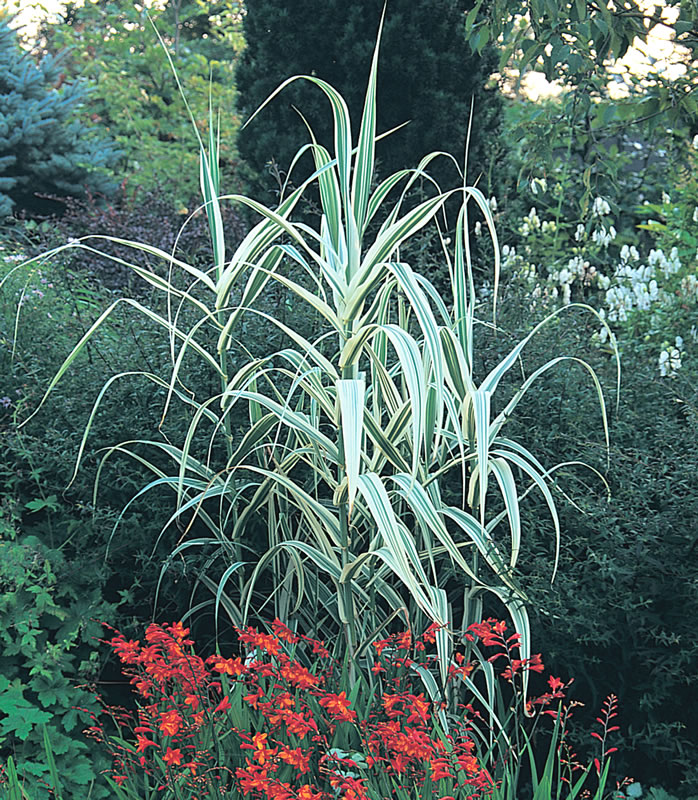
【学名】Miscanthus sinensis‘Variegatus’
【科属】禾本科、芒属
【识别特征】为芒的变种,多年生草本,暖季型。株形挺拔,株高60~120cm,叶片条形,有不规则的斑马斑纹。圆锥花序呈扇形,花期8~9月份。
【分布与习性】喜光,耐半阴,耐寒,耐旱,也耐涝,适应性强,不择土壤。但在排水良好的土壤上生长较好。
【繁殖栽培】组培繁殖。
【观赏与应用 叶色美丽而株型挺拔,可孤植或丛植,用于花坛、花境、岩石园、小区别墅 和庭院中,还可作假山、湖边的背景材料。
Miscanthus sinensis, commonly known as Chinese silver grass, Japanese silver grass or eulalia grass, is a clump-forming warm season grass that typically grows to 3-7’ tall. It is native to lowlands and lower alpine areas in Japan, Korea and China. It has escaped gardens and naturalized in over 25 states in the Central and Eastern U.S. east of the Mississippi River plus in several western States including Colorado and California.
This grass features a dense clump of upward-arching stems and leaves which give it a rounded, fountain-like appearance. Linear leaves (to 3-4’ long and 3/8” wide) have tapered tips, serrate margins and whitish to silvery midribs. Foliage often turns attractive shades of yellow to orange by mid-fall before gradually fading to beige-tan for winter. Pink to red flowers in feathery, whisk-like, loose terminal panicles (8-10” long) bloom above the foliage from late August to October. Flower panicles gradually turn beige by mid-fall as the seeds mature. Flower panicles and foliage both retain good arching shape, beige color and ornamental interest throughout winter, with enhanced attractiveness often coming from a covering of new fallen snow.
Miscanthus sinensis will spread somewhat invasively in the landscape, particularly in some of the milder areas of its growing range. It often initially spreads to disturbed sites such as roadsides, railroad right-of-ways or woodland margins. Invasive potential for the species is significant, but is of less concern for many of the numerous ornamental cultivars, some of which are sterile.
Genus name comes from the Greek words miskos meaning a stem and anthos meaning flower in reference to the stalked spikelets.
Specific epithet means Chinese.
This grass was once included in the genus Eulalia, but was subsequently reclassified to the genus Miscanthus with retention of its common name of Eulalia grass by many gardeners.
'Variegatus' is a variegated eulalia grass cultivar which typically grows in an arching, rounded clump to 5-6' tall (flower plumes can increase height to as much as 7- 9' tall). Features leaf blades variegated with green and white stripes, with white being the predominant color from a distance. Foliage fades to tan after frost. Tiny reddish flowers appear in tassel-like inflorescences which rise above the foliage clump in September, gradually turning into silvery plumes in fall as the seeds mature. Plumes persist well into winter providing good winter interest.

【学名】Spodiopogon sibiricus Trin.
【别名】大荻
【科属】禾本科、大油芒属
【识别特征】多年生草本,暖季型。丛生,茎秆直立,株高120~180cm。叶片呈宽线形,亮绿色,开展,秋天变为紫色。圆锥花序,亮紫色,花期8~11月份。花出后叶片略显零乱。
【分布习性】产东北、华北、华东、华中、西北省区。喜光,较耐阴。耐寒性强,对土壤要求不严,在干旱贫瘠的土壤上也可以生长良好。耐盐碱性差。
【繁殖栽培】分株繁殖,管理粗放。
【观赏与应用】适宜孤植或丛植。
Spodiopogon sibiricus is a species of perennial grass in the Poaceae family.
It is native to Siberia, Mongolia, China, Korea, and Japan.
Culms are solitary, erect, 70–200 cm in height, 2–4 mm in diameter, and unbranched.

【学名】Acorus calamus
【别名】臭菖蒲、水菖蒲、泥菖蒲、大叶菖蒲、白菖蒲
【科属】天南星科、菖蒲属
【识别特征】叶从基部抽出,二列状着生,剑状线形,端断尖,基部成鞘状,对折抱茎,中助脉明显,两侧均隆起,每侧有3~5条平行脉。花茎扁三棱形,似叶鞘细。叶状佛焰苞长20~40cm。肉穗花序直立或斜向上生长,圆柱形,似蜡烛,花小黄绿色。
【分布习性】喜生于沼泽、浅水或溪边。有一定的耐寒性,华北地区成宿根状态,每年地上部分枯死,以根茎潜入泥中越冬。
【繁殖栽培】种子繁殖或分株繁殖。生长季适应性较强,可进行粗放管理。生长期内保持水位或土壤潮湿,施追肥2~3次,并注意除草。越冬前要清理地上部分的枯枝残叶,集中烧掉或沤肥。露地栽培2~3年要更新,盆栽2年更换分栽一次。
【观赏应用】菖蒲叶丛翠绿,端庄秀丽,具有香气,适宜水景岸边及水体绿化。也可盆栽观赏或作布景用。叶、花序还可以作插花材料。可栽于浅水中,或作湿地植物,是水景园中主要的观叶植物;还可抑制水体中的蓝藻、球藻等藻类生长,从而改善水质。全株芳香,可作香料或驱蚊虫;茎、叶可入药。
Acorus calamus (also called sweet flag or calamus, among many common names) is a tall perennial wetland monocot of the Acoraceae family, in the genus Acorus.
Sweet Sedge is a perennial herb, 30 to 100 cm tall. In habit it resembles the Iris. It consists of tufts of basal leaves that rise from a spreading rhizome. The leaves are erect yellowish-green, radical, with pink sheathing at their bases, sword-shaped, flat and narrow, tapering into a long, acute point, and have parallel veins. The leaves have smooth edges, which can be wavy or crimped. The sweet sedge can easily be distinguished from the Iris and other similar plants, by the unusual crimped edges of the leaves, the fragant odour it emits when crushed, and the unusual flower spadix.
The solid, triangular flower-stems rise from the axils of the outer leaves. A semi-erect spadix emerges from one side of the flower stem. The spadix is solid, cylindrical, tapers at each end, and is 5 to 10 cm in length. A covering spathe, as is usual with Acoraceae, is absent. The spadix is densely crowded with tiny greenish-yellow flowers arranged in diamond-shaped pattern. Each flower contains six petals and stamens enclosed in a perianth with six divisions and surrounding a three-celled, oblong ovary with a sessile stigma. The flowers are sweetly fragrant. In Europe it flowers for about a month in late spring or early summer, but usually does not bear fruit there. Only plants that grow in water bear flowers. The fruit is a berry filled with mucus, which when ripe falls into the water and thus disperses. Even in Asia it fruits sparingly and propagates itself mainly by spreading its rhizome, forming colonies.
The branched, cylindrical, knobby rhizome is about a finger thick and has numerous coarse fibrous roots below it. The exterior is brown and the interior white.


【学名】Lotus corniculatus L.
【别名】牛角花、五叶草
【科属】豆科、百脉根属
【识别特征】多年生草本。茎直立,高11~45cm。主根深长,侧根多而发达。茎丛生,稀疏长柔毛或无毛。奇数羽状复叶,小叶5枚,卵形或倒卵形,全缘,两面无毛或有柔毛;其中3小叶位于叶柄的顶端,2d,叶常生于叶柄的基部。花3~4朵排列成项生的伞形花序,黄色至橙黄色,基部托着3枚叶状苞片;花期5~7月份。荚果长圆柱形,鲜时紫绿色,干后灰绿色,含多数种子,种子绿色肾形。果期8~9月份。
【分布习性】分布于湖南、湖北、四川、广西、云南、贵卅II、甘肃等地。喜光,也耐阴。喜温暖湿润气候,耐热。耐贫瘠、耐湿、耐盐碱。适宜在肥沃、灌溉良好的黏壤土上生长,但在砂壤土、土层浅,土质瘠薄、低湿排水不良的微酸或微碱性土壤也可生长。
【繁殖与栽培】通常用播种法繁殖。多用秋播,早春播种也可,播种适温15~25。C。苗期应注意清除杂草。
【观赏与应用】因其耐盐碱、耐践踏等多种优点,常种植于岩石园、野生植物园的树下浓荫 处作缀花地被植物。茎干可作饲料,一年收2~3次。
Lotus corniculatus is a common flowering plant in the pea family Fabaceae, native to grassland in temperate Eurasia and North Africa. Common names include common bird's-foot trefoil and just bird's-foot trefoil, though the common name is often also applied to other members of the genus. It is also known in cultivation in North America as bird's-foot deervetch.
It is a perennial herbaceous plant, similar in appearance to some clovers. The flowers are mostly visited by bumblebees and develop into small pea-like pods or legumes. The name 'bird's foot' refers to the appearance of the seed pods on their stalk. Five leaflets are present, but with the central three held conspicuously above the others, hence the use of the name 'trefoil'. It is often used as forage and is widely used as food for livestock due to its nonbloating properties.

【学名】Trifolium repens
【别名】白车轴草、三叶草、白三叶
【科属】豆科、三叶草属
【识刖特征1】多年生草本,冷季型草。植株低矮,分枝多,根部分蘖能力及再生能力均强,根部有共生的根瘤菌。匍匐枝爬地生长,节间着地生根,并萌发新芽。三叶着生于长柄顶端,故名“三叶草”。头状总状花序,高出于叶;花冠白色或淡红色,花期5月份。
【分布与习性】喜温暖湿润气候,耐热性稍筹差,抗寒性较强。喜阳光,能耐半阴。不耐干旱,稍耐潮湿。不耐盐碱,在含盐量稍大的土壤中不能长久生存。
【繁殖栽培】播种繁殖。种子发芽容易,出苗率高。苗期应适时清除杂草,以利白三叶草成坪。由于有固氮能力,对肥料要求不多。但在久旱不降雨时,要注意及时浇水抗旱。(https://www.daowen.com)
【观赏应用】叶丛低矮,开花多,绿色期长,常用于缀花草坪。根系发达,地面覆盖度好是优良的固土护坡植物。
Trifolium repens, the white clover (also known as Dutch clover, Ladino clover, or Ladino), is a herbaceous perennial plant in the bean family Fabaceae. It is native to Europe and central Asia. One of the most widely cultivated types of clover, it has been widely introduced worldwide as a forage crop, and is now also common in most grassy areas (lawns and gardens) of North America and New Zealand. The species includes varieties often classed as small, intermediate and large, according to height, which reflects petiole length. The term “white clover” is applied to the species in general, “Dutch clover” is often applied to intermediate varieties (but sometimes to smaller varieties), and “ladino clover” is applied to large varieties.
The genus name, Trifolium, derives from the Latin tres, "three", and folium, "leaf", so called from the characteristic form of the leaf, which usually but not always has three leaflets (trifoliate); hence the popular name "trefoil". The species name, repens, is Latin for "creeping".

【学名】Miscanthus giganteus
【别名】芒杞
【科属】禾本科、芒属
【识别特征】暖季型草。株形健壮,株高2~3.5m,横生茎与秆丛集,秆直立。叶缘齿状,叶片绿色,长势极其旺盛。花序外形似荻,花期9~10月份。最佳观赏期6~11月份。
【分布习性】由日本引入欧洲的一种高大禾草,在欧洲已有数十年的栽培历史,今年从德国引入中国。喜光,耐寒,由于具有强壮的根系,该品种的抗逆性极强,既耐旱又耐涝。
【繁殖栽培】分株繁殖,管理粗放。
【观赏应用】植株刚劲挺拔,气势雄伟、壮观,秋季银白色花序质朴自然,具有很高的观赏价值。可片状或宽带状种植,亦可孤植,用于花坛、花境栽植。也是一种有潜力的工业原料和绿色能源植物。
Miscanthus × giganteus, giant miscanthus, is a large, perennial grass hybrid of Miscanthus sinensis and Miscanthus sacchariflorus. This full sun plant grows 8-12 ft (240–360 cm) tall each year and is best suited for hardiness Zones 5 - 9.
M. × giganteus is a C4 plant, and thus exhibits greater photosynthetic efficiency and lower water use requirements than other kinds of plants.[4] It has very low nutritional requirements – it has high nitrogen use efficiency and therefore is capable of growing well on barren land without the aid of heavy fertilization. M. × giganteus is a sterile hybrid and therefore propagates vegetatively underground through its rhizomes. Additional researched benefits of M. × giganteus include its ability to sequester carbon into the earth.
It is currently used in the European Union as a commercial energy crop, as a source of heat and electricity, or converted into biofuel products such as ethanol.
Manufacturers such as AgriKinetics, NNRGY Crops, and Aloterra are currently exploring the possibility of using Miscanthus grass as input for plastics and other products traditionally constructed from petroleum fuels, trees or land resources (for example limestone).
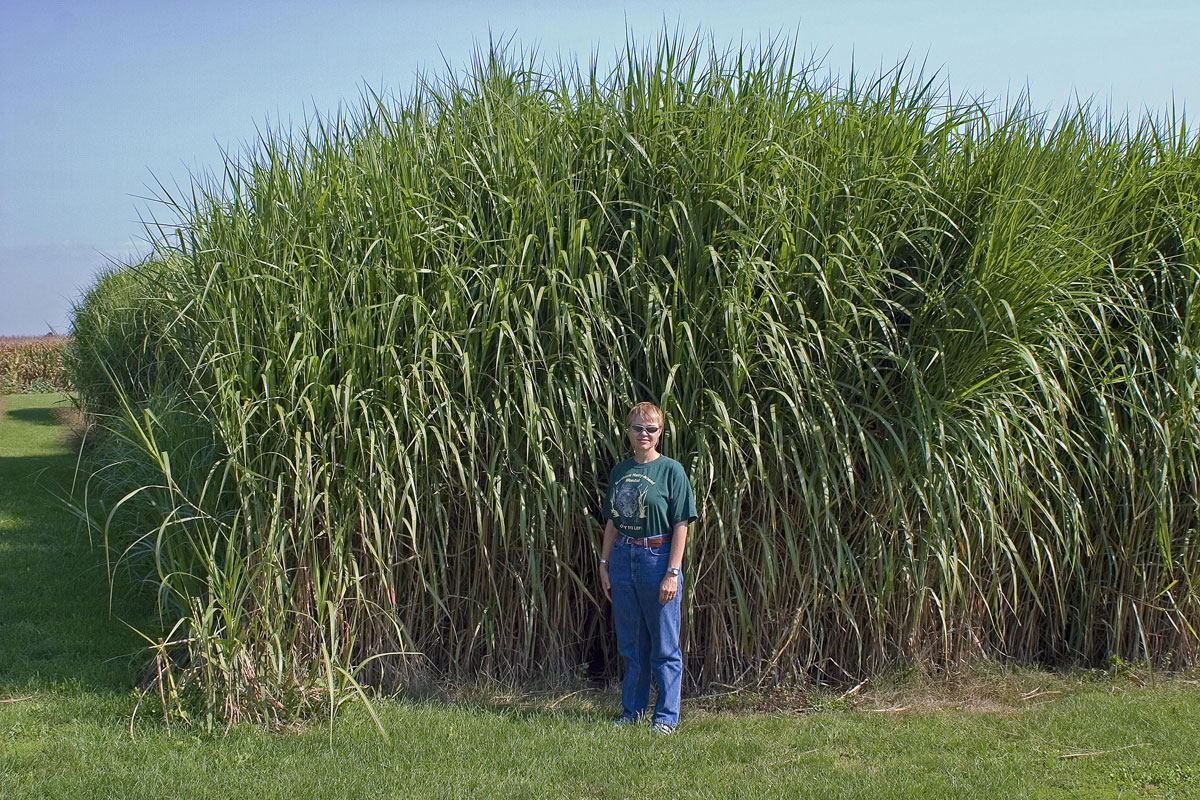
【学名】Panicum virgatum
【科属】禾本科、稷属
【识别特征】多年生草本,暖季型,株高80~120cm。叶挺直,呈绿色或灰绿色,秋季变为黄色。圆锥花序,绿色,种子成熟时变为黄色。仲夏或夏末开花,一直持续到冬季。
【分布习性】喜光,耐轻度庇荫。不择土壤,能忍受长期干旱。
【繁殖与栽培】播种、组培繁殖。
【观赏应用 可片植或条带种植,是配置花境的理想材料。目前,柳枝稷在美国园林栽培品种中野生驯化品种逐渐增多,凭借其旺盛的生命力和多变的形态,从路边无人问津的野草逐渐成为美国现代园林的新星。在我国园林中应用也很受欢迎。
Panicum virgatum, commonly known as switchgrass, is a perennial warm season bunchgrass native to North America, where it occurs naturally from 55°N latitude in Canada southwards into the United States and Mexico. Switchgrass is one of the dominant species of the central North American tallgrass prairie and can be found in remnant prairies, in native grass pastures, and naturalized along roadsides. It is used primarily for soil conservation, forage production, game cover, as an ornamental grass, in phytoremediation projects, fiber, electricity, heat production, for biosequestration of atmospheric carbon dioxide, and more recently as a biomass crop for ethanol and butanol. Other common names for switchgrass include tall panic grass, Wobsqua grass, blackbent, tall prairiegrass, wild redtop, thatchgrass, and Virginia switchgrass.
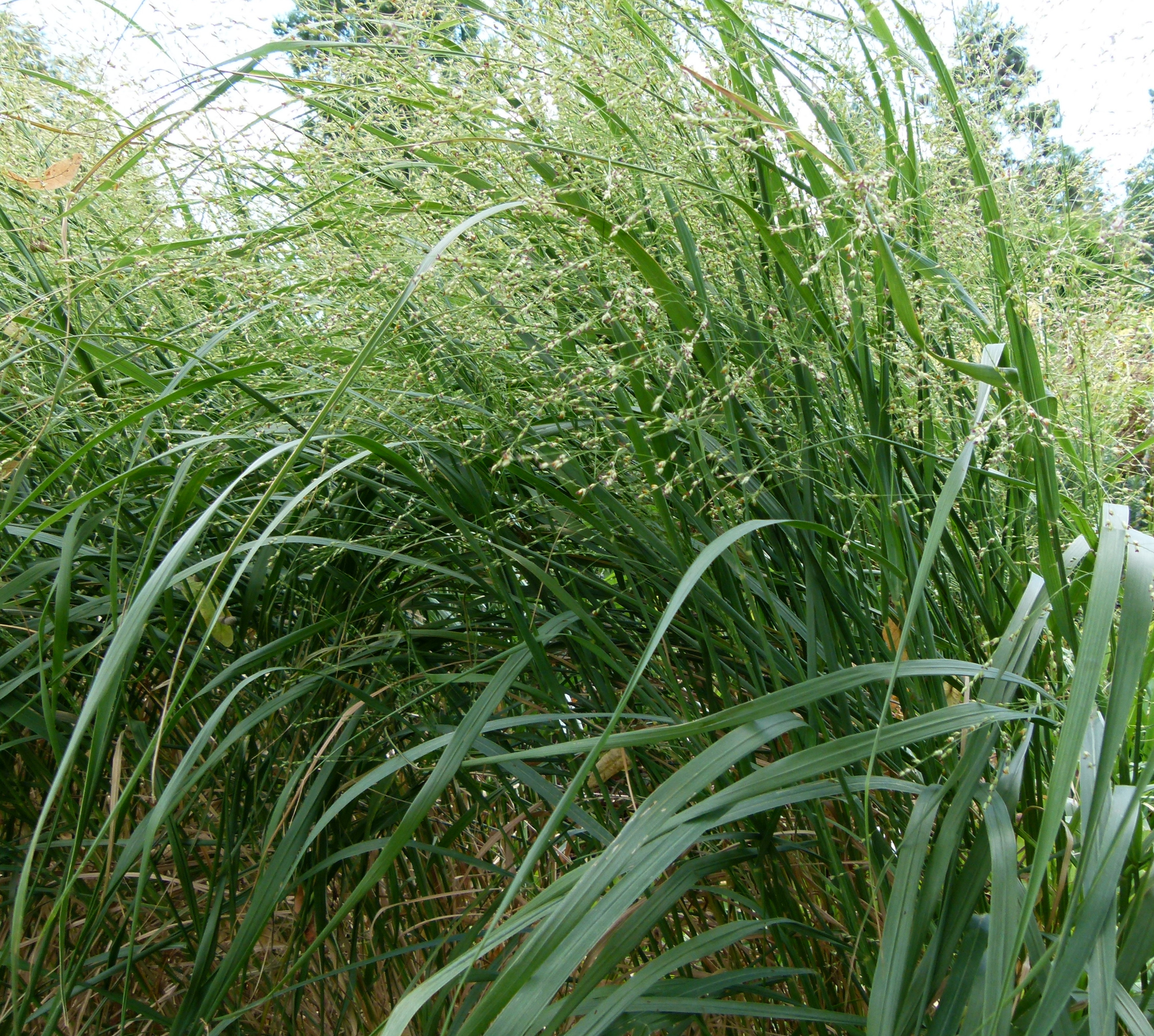
【学名】Reineckea carnea (Andr.)kunth
【科属】禾本科、鹬草属
【识别特征】多年生宿根常绿草本。株高30~60cm,茎较短。叶扁平线形,丛生,叶片色泽碧绿,密布银白色条纹。圆锥花序分枝细长,梢部下垂,夏初开花。
【分布与习性】原产北美和欧洲,现中国南北各地广为栽培。适应性强,抗寒,适合生长温度15~25℃,在北京地区可以露地越冬。耐旱,忌雨涝。不择土壤,田园土、砂质土均能生长。
【繁殖与栽培】可分株或播种繁殖。每年4月中旬及9月初修剪1次,并适当施追肥,促使植株健壮生长。
【观赏与应用】玉带草四季常青,叶片白绿相问,非常秀美。可用作花坛、花境镶边材料,是理想的彩叶地被梢物。伯可岔裁卿常.或作切叶材料。
【学名】Isolepiscernua
【别名】纤维光草、垂花荸荠、蔗草
【科属】莎草科、蔗草属
【识别特征】美国育种公司推出的一个小型独特的观叶植物,株高15~20cm,冠幅25~50cm。植株呈伞状,叶片纤细,顶端着生小花,芳香。如人造光纤饰品,故得名。
【分布与习性】喜湿润、庇荫,如果湿度合适,也可以在阳光下生长。
【繁殖与栽培】播种繁殖。常用10~15cm的花盆栽植。幼苗期植株向上生长,成熟后会自然下垂,使株型自然密实、圆润,不需打项或施用生长调节剂。
【观赏与应用】光纤草是外观奇特的观赏草,其纤细的叶片镶嵌着一朵朵小花,看起来像是光导纤维。适合于组合盆栽室内观赏。因其喜湿润,也是池塘、水边较好的配景植物材料。
Isolepis cernua (syn. Scirpus cernuus) is a species of flowering plant in the sedge family known by the common names low bulrush, slender club-rush, tufted clubrush, and fiberoptic grass. It is widespread, being native to many regions of the world, including parts of Australasia, Eurasia, Africa, and North and South America.


【学名】Saivia officinalis
【别名】洋苏叶
【科属】唇形科、鼠尾草属
【识别特征】多年生草本,成株高80cm,盆栽30~50cm;根系发达,地上部分丛生,茎近于木质,较矮。叶对生,灰银色,椭圆形,有锯齿,叶柄较长,上密布白色绒毛,触感犹如天鹅绒,基部叶片近叶柄较窄,茎上叶片长,较尖。花6~10朵成串轮生于茎顶花序上,蓝紫色至粉紫色,香味浓郁,花期夏季。
常见品种有原生鼠尾草,黄金鼠尾草,三色鼠尾草,粉萼鼠尾草等。
【分布与习性】产浙江、安徽南部、江苏、江西、湖北、福建、台湾、广东、广西等地,日本也有。喜温暖、阳光充足的环境,不择土壤,耐干旱,但不耐涝,特别喜石灰质丰富或沙性、排水良好的土壤。极寒冷地区作一年生栽培。
【繁殖与栽培】扦插、压条或播种繁殖。需种植于排水良好和日照充足的土壤上,尤以碱性土壤为佳。株高5~lOcmH脯,使苗间距20~30cm。成株后可再次疏剪,增加距离,生长较旺。
【观赏与应用】 既是优良的观赏植物,也是重要的药用植物,花可用来泡茶,散发清香味,可清除体内油脂,帮助循环,养颜美容,具有防腐、抗菌、抗炎之效。
Salvia officinalis (sage, also called garden sage, common sage, or culinary sage) is a perennial, evergreen subshrub, with woody stems, grayish leaves, and blue to purplish flowers. It is a member of the mint family Lamiaceae and native to the Mediterranean region, though it has naturalized in many places throughout the world. It has a long history of medicinal and culinary use, and in modern times as an ornamental garden plant. The common name "sage" is also used for a number of related and unrelated species.

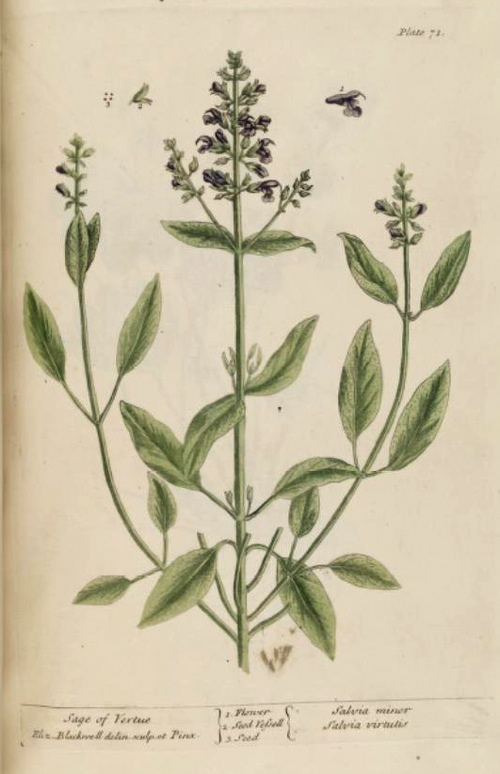
【学名】Andropogon yunnanensis Hack
【科属】禾本科、须芒草属
【识别特征】多年生草本,暖季型草。秆密、丛生,圆柱形,粗壮,高1.5m左右。叶长披针形,灰绿色至紫色。叶缘粗糙,花序为具鞘状总苞假圆锥花序,由成对总状花序组成。5月初开始抽穗,开花盛期在8月中旬至9月下旬,颖果纺锤状,10月份种子成熟,冬季并不枯黄,保持青绿状越冬。最佳观赏期7~11月份。
【分布习性】喜光,耐热,耐旱,耐酸,在pH为4.6的土壤上能繁茂生长;耐瘠薄土壤。耐火烧,根系发达,入土深度80cm,肥沃疏松的土壤可达3m以上。
【繁殖与栽培】分株繁殖,管理粗放。
观赏应用 秋天整个植株变为紫红色,白色柔毛伸出颖壳,景观效果独特。主要作为园林景观中的点缀植物,孤植或从植于花坛、花境及庭院.还可盆栽欣赏。
An Andropogon yunnanensis in uska species han Liliopsida nga ginhulagway ni Eduard Hackel. An Andropogon yunnanensis in nahilalakip ha genus nga Andropogon, ngan familia nga Poaceae. Waray hini subspecies nga nakalista.
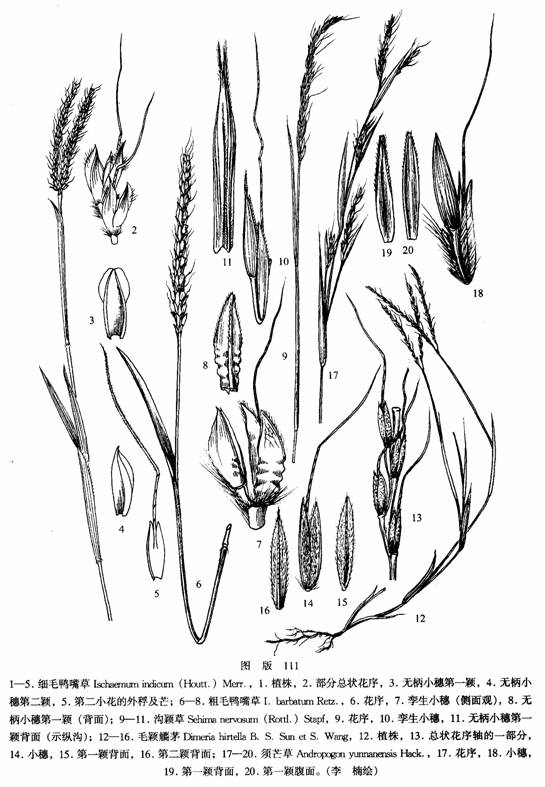
【学名】Tulbaghia vielacea
【别名】野蒜、非洲小百合
【科属】石蒜科、紫娇花属
【识别特征】常绿多年生球根草本,株高30~50cm,具圆柱形小鳞茎,成株丛生状。茎叶均含有韭味。叶线形或线状披针‘形。顶生聚伞花序,开紫粉色小花。花期5~11月份。
【分布与习性】原产南非。喜光,栽培处全日照、半日照均理想,但不宜庇荫。喜高温,耐热,生育适温24~30。C。对土壤要求不严,耐贫瘠。但肥沃而排水良好的沙壤土或壤土上开花旺盛。
【繁殖栽培】 可用播种、分株或鳞茎繁殖。全年均可进行,成活率极高,只要掘取带有鳞茎的幼株或成株另植即可。掘取的鳞茎最好有3~4个连附者为佳,伸长的叶片剪去2/3再种植。
【观赏应用】花期极长,几乎全年均能开花,但以夏秋季开花最盛。可作庭院栽植、盆栽或切花。
Tulbaghia violacea, also known as society garlic or pink agapanthus, is a species of flowering plant in the onion family Alliaceae, indigenous to southern Africa (KwaZulu-Natal and Cape Province), and reportedly naturalized in Tanzania and Mexico.
Growing to 60 cm (24 in) tall by 25 cm (10 in) wide, it is a clump-forming perennial with narrow leaves and large clusters of fragrant, violet flowers from midsummer to autumn (fall).
When grown as an ornamental, this plant requires some protection from winter frosts. It has gained the Royal Horticultural Society's Award of Garden Merit.


【学名】 Eragrostis pilosa (L.)Beauv.
【别名】星星草、绣花草、蚊子草
【科属】禾本科、画眉草属
【识别特征】 一年生草本植物,暖季型。秆丛生,株高40~80Cm o叶片长40~50cm,狭条状,叶舌有一圈短纤毛绿色;叶鞘光滑或鞘口生长柔毛,有脊。开放型圆锥花序,小穗长圆形着3-14朵小花;花期6~10月份。颖果长圆形,黄棕色。最佳观员别7~11月份。
【分布与习性】喜光,耐旱,耐贫瘠,喜潮湿肥沃的土壤。
繁殖与栽培 播种繁殖,可春播或秋播。栽植容易,病虫害少,养护管理粗放。
观赏应用 开花如满天星般繁密,且花期较长,长达5个月。主要作为园林景观中的点缀植物,多孤植,或用于花带、花境配置。在公路、护坡等处种植也非常适宜。
Eragrostis pilosa is a species of grass. It is native to Eurasia and Africa. It may or may not be native to North America. It is widely introduced, and it is a common weed in many areas.
Common names include Indian lovegrass, Jersey love-grass, hairy love grass, small tufted lovegrass, soft lovegrass (English), éragrostide poilue, pâturin poilu (French), barba de indio, pasto ilusión, pasto pelillo, sereno (Spanish), hua mei cao (Chinese), behaartes Liebesgras (German), capim-barbicha-de-alemão, panasco (Brazilian Portuguese), and gangami subu (Zarma).


【学名】Imperata cylindrica‘Rubra’
【科属】禾本科、白茅属
【识别特征】多年生草本,株高60cm。叶丛生,剑形,常年保持深血红色。圆锥花序,小穗银白色,花期夏末。
【分布与习性】由日本引进,也叫“日本血草”。喜光或有斑驳光照处。耐热,喜湿润而排水良好的土壤。
【观赏与应用】是优良的彩叶观赏草。可片植,营造整齐、壮观且富于动感的色块景观。或与其他观赏草、宿根花卉及花灌木等搭配组合种植,可营造不同主题的混合花境。也可盆栽观赏,摆放在居室、阳台或庭院中。
Imperata cylindrica (commonly known as cogon grass /koʊˈɡoʊn/, kunai grass /ˈkuːnaɪ/, blady grass, alang-alang, cotton wool grass, kura-kura) is a species of grass in the family Poaceae. Red cultivars of the species grown as ornamental plants are known as Japanese bloodgrass.
It is a perennial rhizomatous grass native to east and southeast Asia, India, Micronesia, Melanesia, Australia, and eastern and southern Africa. It grows from 0.6 to 3 m (2 to 10 feet) tall. The leaves are about 2 cm wide near the base of the plant and narrow to a sharp point at the top; the margins are finely toothed and are embedded with sharp silica crystals. The main vein is a lighter colour than the rest of the leaf and tends to be nearer to one side of the leaf. The upper surface is hairy near the base of the plant while the underside is usually hairless. Roots are up to 1.2 meters deep, but 0.4 m is typical in sandy soil.


【学名】Miscanthus sacchariflorus
【别名】岗柴、江荻
【科属】禾本科、芒属
【识别特征】多年生草本植物。株高0.6~5m,叶片条形细长,似芦苇。圆锥花序,黄褐色或紫红色。
【分布与习性】中国为荻的主产国,主要分布在江苏、江西、安徽、湖南、湖北等省。耐寒,耐旱,不择土壤。
【繁殖栽培】分株繁殖,管理粗放。
【观赏应用】荻为乡土草种,可片状或宽条带状种植于浅水区、水岸边,或用作背景材料。
Miscanthus sacchariflorus (common name: Amur silver-grass) is a grass native to temperate Northeast Asia.
Culms are erect, 90 centimetres (35 in) – 250 centimetres (98 in) in height and 5 millimetres (0.20 in) – 8 millimetres (0.31 in) in diameter.


【学名】Arrhellatherum elatius var.tuberosum f.variegatuum
【别名】块茎燕麦草、条纹燕麦草、丽蚌草
【科属】禾本科、燕麦草属
【识别特征】多年生宿根草本,冷季型草。地下茎为白色念珠状:植株低矮,高约20~40cm,丛生状。叶线状披针形,叶面有白色纵纹,叶缘白色。
【分布习性】原产欧洲。喜光,也耐阴。喜凉爽湿润气候,耐寒,忌酷暑,夏季高温时处于休眠或半休眠状态,越冬需10℃以上。需通气良好,不耐干燥,避寒风。耐旱,不择土壤,但在肥沃而排水良好的沙壤土或腐殖质土生长最佳。
【繁殖栽培】可用分株或扦插繁殖。通常2~3年分株1次,在春季3~4月份或于9月份休眠后初抽新叶时进行,将老株掘起后进行分离,每株宜带2~3个新芽,并连同念珠状地下茎一起分离。
栽培容易。老株每年应注意修剪,叶片不要过长,当地下茎露出后应及时培土,使植株丛旺盛而优美。生长期内,每月施1~2次稀薄饼液肥。不宜施肥过多,否则叶片白斑就会消失而呈绿色影响观赏效果。
【观赏与应用】银边草叶片白绿相间,非常雅致,是很好的花带、花坛和花境等镶边材料。园林中多从植或与山石配植,效果较好。它还可有效去除氨气等毒气,过滤浊气,增加室内负离子数量,较适合室内应用。
rrhenatherum elatius, with the common names false oat-grass, tall oat-grass, tall meadow oat, onion couch and tuber oat-grass, is a perennial species of grass, common in the temperate regions of Europe.
This bunchgrass is often used as an ornamental grass.
It is native to Europe but can be found elsewhere as an introduced species. It is found especially in prairies, at the side of roads and in uncultivated fields. The bulbous variety can be a weed of arable land. It is palatable grass for livestock and is used both as forage (pasture) and fodder (hay and silage); it has high amounts of phosphorus and calcium in its tissues.
【学名】Deschampsia caespitosa
【科属】禾本科、发草属
【识别特缸】多年生草本,冷季型。株高1m左右,密簇丛生,叶片狭细,深绿色,早春开始生长。圆锥花序开展,长20~25cm,突出植株约50cm;淡绿色,花期5~6月份。春夏叶子会发黄,略有枯萎状。
【分布习性】全日照或部分荫蔽长势最好。喜中性或弱酸性土壤,稍耐盐碱。耐霜冻,不耐涝。
【繁殖与栽培】分株繁殖,管理粗放。
【观赏与应用】片植、盆栽观赏或花坛镶边效果最佳。
Deschampsia cespitosa, commonly known as tufted hairgrass or tussock grass is a perennial tufted plant in the grass family Poaceae.[2] Distribution of this Deschampsia grass species is widespread including the eastern and western coasts of North America, parts of South America, Eurasia and Australia.
【学名】Arundinella hirta (Thunb.)
【科属】禾本科、野古草属
【识别特征】一年生或多年生疏丛型草本,茎直立,株高60~100cm。叶片狭披针形。圆锥花序紧缩,由绿色渐渐变为紫色。
【分布习性】除新疆、西藏、青海未见本种外,全国各省区均有分布。耐寒,耐热,耐旱,抗盐碱、抗风沙能力强,在荒山、荒坡和荒漠地区均有生长,但不耐庇荫。
【繁殖栽培】播种繁殖,管理粗放。
【观赏与应用】野古草在园林中宜丛植观赏,还是一种很好的护坡、水土保持和固沙植物,可以进行荒山、荒坡改造,增添野趣。
An Arundinella hirta in uska species han Liliopsida nga syahan ginhulagway ni Carl Peter Thunberg, ngan ginhatag han pagkayana nga asya nga ngaran ni Tyôzaburô Tanaka. An Arundinella hirta in nahilalakip ha genus nga Arundinella, ngan familia nga Poaceae. Waray hini subspecies nga nakalista.
【学名】Cotaderia selloana(Schult)
【科属】禾本科、蒲苇属
【识别特征】多年生草本植物,茎丛生,雌雄异株,株高2.4~3.7m。叶多聚生于基部,极狭,下垂,边缘具细齿,呈绿色或灰绿色,被短毛,在温暖地区常绿,在冷凉地区冬季植株为黄褐色。圆锥花序大,雌花穗银白色或粉色,具光泽。夏末或早秋开花,一直到冬季。
【分布习性】产华北、华中、华南、华东及东北地区。适应性强,耐寒,喜温暖、阳光充足及湿润气候。对土壤要求不严.在湿润肥沃的土壤上生长茂盛。
【繁殖栽培】常用播种繁殖,在9月中旬到10月上旬,当花序散开、种子成熟时选取饱满的花穗及时采收,随采随播,新鲜的种子发芽率高。或春季分株繁殖。易栽培,管理粗放,可露地越冬。
【观赏与应用】蒲苇花穗长而美丽,飘逸洒脱,可庭院栽培或植于河塘边、溪边,入秋赏其银白色圆锥花序。或在观赏草专类园内使用,增添一种野趣的效果,具有优良的生态适应性和观赏价值。也可用作干花,在孕穗时剪下,即可长时期观赏。
Cortaderia selloana, commonly known as pampas grass, is a flowering plant native to southern South America, including the Pampas region after which it is named. There are around 25 species in the genus Cortaderia.
It is a tall grass, growing in dense tussocks that can reach a height of 3 m (10 ft). The leaves are long and slender, 1–2 m (3 ft 3 in–6 ft 7 in) long, and 1 cm broad, with very sharp edges. The leaves are usually bluish-green, but can be silvery grey. The flowers are produced in a dense white panicle 20–40 cm (8–16 in) long on a 2–3 m (6 ft 7 in–9 ft 10 in) tall stem.
The specific epithet was given by Josef August and Julius Hermann Schultes in 1827, after the German botanist and naturalist Friedrich Sellow, who studied the flora of South America, especially that of Brazil.
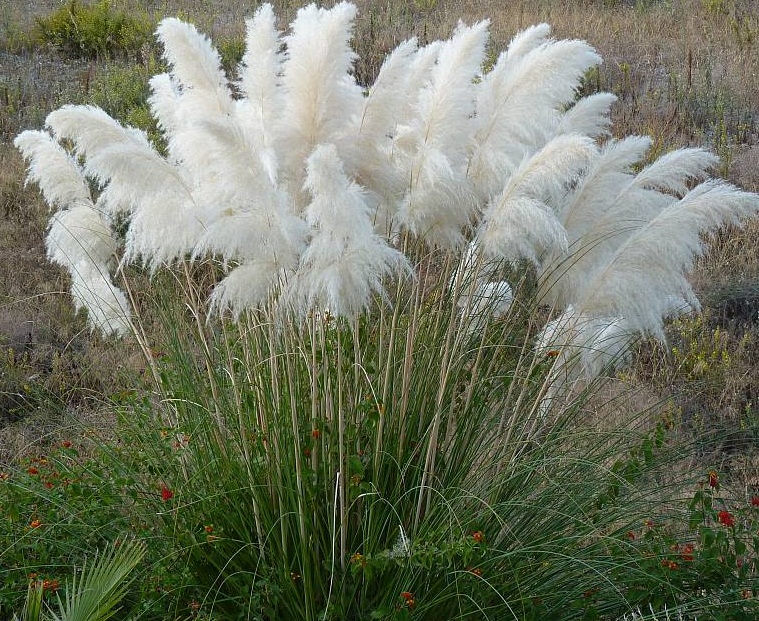
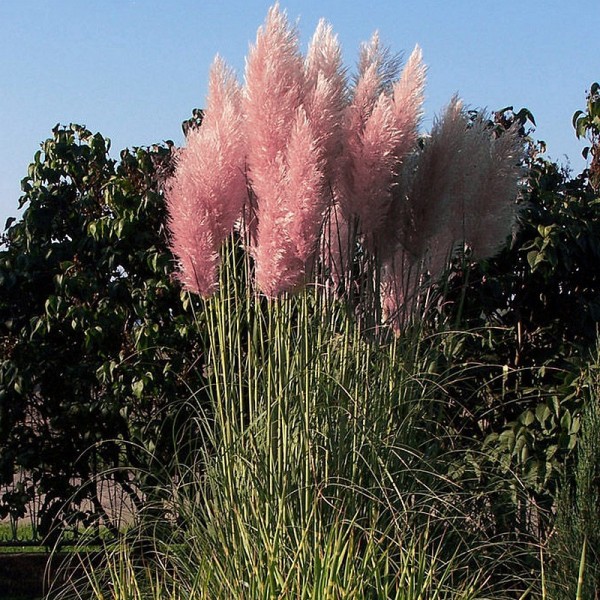
免责声明:以上内容源自网络,版权归原作者所有,如有侵犯您的原创版权请告知,我们将尽快删除相关内容。






